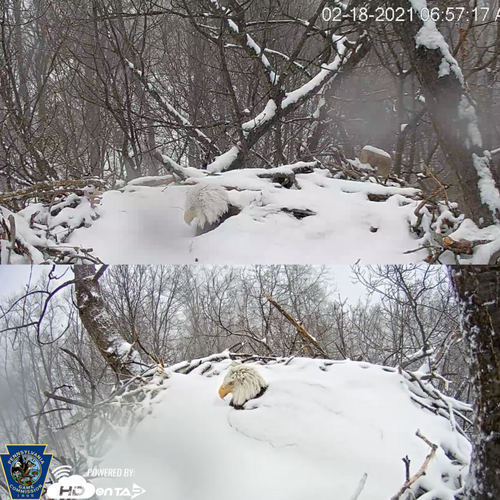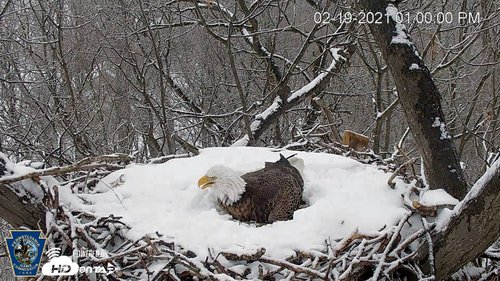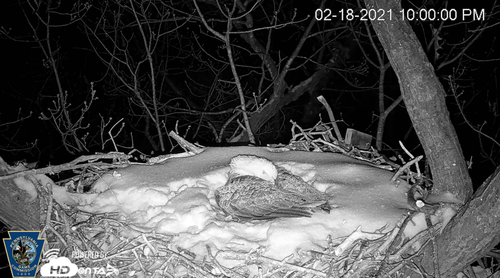Hanover Bald Eagle Blog # 8 - 2021
In partnership with Pennsylvania Game Commission and Comcast Business .
This week we watched the Hanover eagles incubate their eggs with wings spread, protecting the next generation from snow and ice, while a winter wind howled through the branches. The obvious question is, of course, how on earth do they deal with that? Bald eagles employ a variety of behavioral and physiological tricks to help them weather the weather, and although it can be difficult to watch a mother sit on a nest covered in snow, we can rest assured that bald eagles have been handling winters for a very long time. In other words, they’ve got it down.

One of their primary tactics is to reduce physical activity. The more activities an animal engages in, the more energy they use up, and the more often they need to replenish their reserves. During the winter, fish are often sealed beneath ice and carcasses may be covered in snow. Therefore, saving energy is the name of the game, and indeed, studies have indeed shown that bald eagles remain mostly sedentary during the cold months.
Bald eagles sometimes form communal roosts in the wintertime, most likely to increase their chances of finding food. As the saying goes, the more eyes the better, and this is especially true for scavenging birds of prey who may need to range far and wide to find enough to eat. By roosting near others, individual bald eagles can gather information from the comings and goings of other eagles, therefore increasing their chances of finding food.
Like other animals, bald eagles seek shelter to escape the elements, often using conifer trees which offer cozy protected nooks during both day and night. Conifer trees retain heat beneath their branches, making them optimal bedrooms for a variety of animals, including deer which often bed down beneath conifers.

Bald eagles also reduce their body temperature at night. In a 1984 study conducted on free-ranging bald eagles in the Pacific Northwest, researchers found that the body temperature of resting bald eagles decreased by roughly 3.4°F at night. This allows them to save the energy they would otherwise use to keep warm, and also reduces the temperature difference between their bodies and the outside air, which in turn reduces their heat loss.
Bald eagles also choose sleeping postures that keep their vulnerable, non-feathered appendages protected from the cold winter air. These appendages, like beaks and feet, are big sources of heat loss. By tucking their beak into their back feathers when they sleep, as we often see the Hanover eagles doing, they prevent valuable heat from escaping into the night air. Birds do the same thing by tucking one foot up into their abdomen feathers. Bird feathers are miraculously efficient at protecting against cold air, snow, rain, and even ice. The body feathers zip together and provide a watertight seal that keeps the fluffy, insulating downy feathers protected enough to do their job.

And of course, there’s the matter of the bald eagle’s size. There is a fancy physics principle that says the bigger an animal, the better they are at retaining heat because the ratio between the mass and surface area of the animal is lower. Eagles have a low surface-area-to-mass ratio which means they resist heat loss more effectively than smaller birds. However, this is a trade off because being big means that eagles require a lot of food. So, being big is not enough: They also need to be efficient foragers, which bald eagles most certainly are.
In short, the Hanover eagles survive the cold with nothing more than the natural wonders of their own biology and behavioral tenacity, demonstrating a heartiness that we can scarcely imagine from our sealed-in homes and winter parkas.
Watch this video for a visual interpretation of how surface-area-to-mass works in animals:
Surface Area to Volume: The bigger they are, the harder they cool

Sources
Stalmaster, M.V., and J. A. Gessaman (1984). Ecological energetics and foraging behavior of overwintering Bald Eagles. Ecological Monographs 54: 407-428.
ATTENTION HANOVER EAGLE VIEWERS - We recognize that over the years this bald eagle pair has been named by the public and is commonly referred to as "Freedom" and "Liberty". While we understand that naming the eagles helps connect and distinguish the female from the male eagle, naming the pair introduces an element of domesticity to wild animals. In order to respect the eagles and focus on their natural history, we will refer to the female and male as such as per recommendations of the Pennsylvania Game Commission.


RETURN TO HANOVER BALD EAGLE BLOGS
WATCH THE HANOVER BALD EAGLE LIVE CAMS
For over 20 years, HDOnTap has provided live streaming solutions to resorts, amusement parks, wildlife refuges and more. In addition to maintaining a network of over 400 live webcams, HDOnTap specializes in design and installation of remote, off-grid and otherwise challenging live streaming solutions. Contact press@hdontap.com for all media needs, including images and recordings.